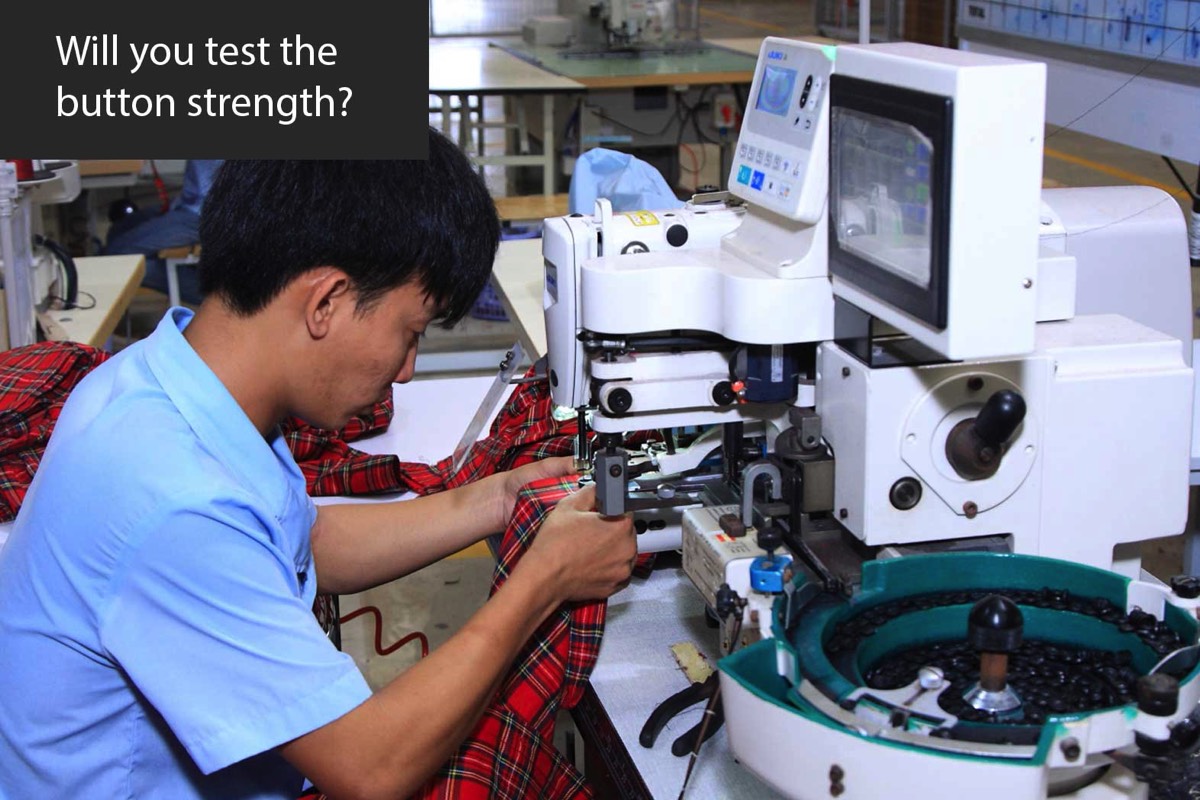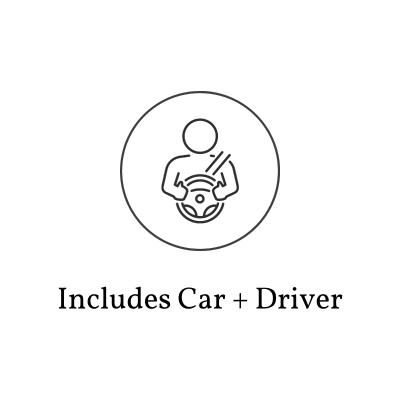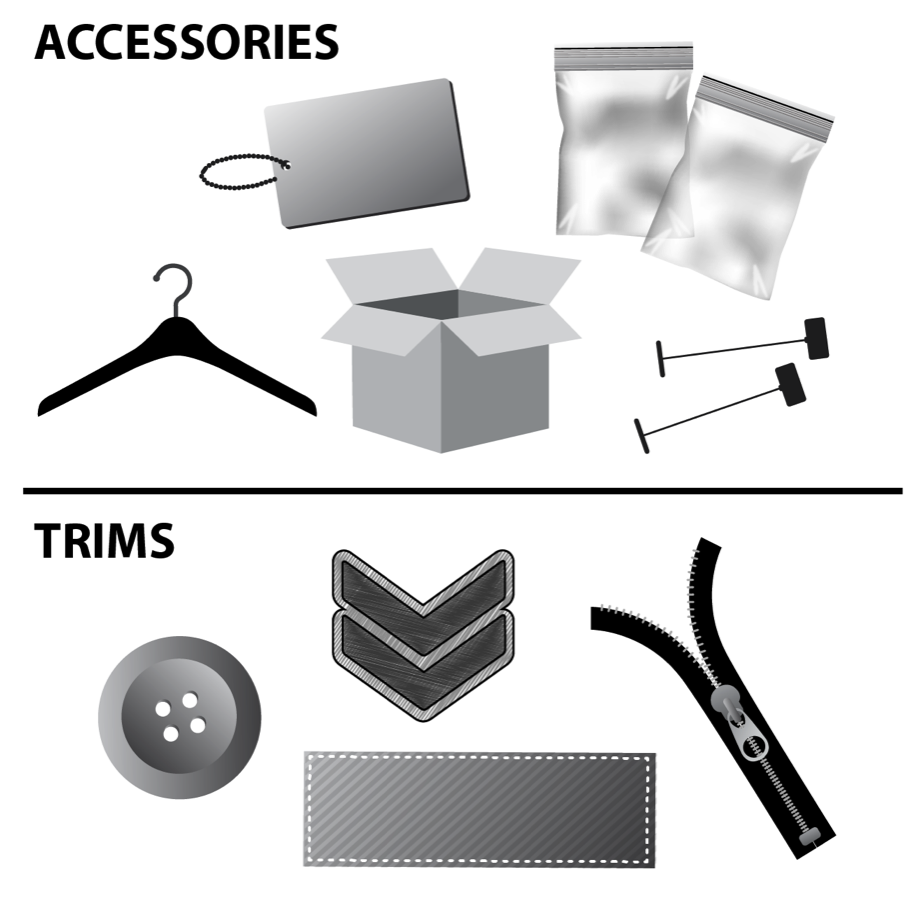Sourcing Fabric Trims in Vietnam
What exactly are trims?
A trim is anything that stays on the garment when you first put it on. For example, let’s say your shirt has a varsity patch that is sewn on the front pocket. When you put the shirt on, the patch does not fall off.
The patch is a trim. In contrast, if your shirt has a hangtag, when you first put the shirt on, the hangtag is cut off and ends up in the trashcan. The hangtag is an accessory. In other words, when you first unwrap the garment from the store, things like buttons and care labels will stay on the garment whereas polybags and hangtags will be thrown in the trash.
Here is a list of common trims:
• Main Label
• Care Label
• Buttons
• Zippers
• Branding Labels
• Rib Cuffs
• Collars
Watch my introduction video and keep reading below if you would like to produce in Vietnam. I can help you.
The patch is a trim. In contrast, if your shirt has a hangtag, when you first put the shirt on, the hangtag is cut off and ends up in the trashcan. The hangtag is an accessory. In other words, when you first unwrap the garment from the store, things like buttons and care labels will stay on the garment whereas polybags and hangtags will be thrown in the trash.
Here is a list of common trims:
• Main Label
• Care Label
• Buttons
• Zippers
• Branding Labels
• Rib Cuffs
• Collars
Watch my introduction video and keep reading below if you would like to produce in Vietnam. I can help you.
Services We Offer
eBooks
Courses
Consultation
Factory Introductions
Factory Tours
Production A to Z
When is a good time to schedule a time to talk?
Please fill in our contact form below,
then click the submit button.
See you in Vietnam!
Where can we source fabric trims in Vietnam?
This page is about Sourcing Fabric Trims in Vietnam
The factory is going to ask you some specific questions about trims. When working with merchandisers they will ask questions like:
What kind of main label do you want?
What needs to be written on the care label?
Do you want plastic or seashell buttons?
Do you want cheap or expensive zippers?
Need help sourcing trims in Vietnam? I can point you in the right direction.
The factory is going to ask you some specific questions about trims. When working with merchandisers they will ask questions like:
What kind of main label do you want?
What needs to be written on the care label?
Do you want plastic or seashell buttons?
Do you want cheap or expensive zippers?
Need help sourcing trims in Vietnam? I can point you in the right direction.

Schedule a Factory Tour Today!



Do you know what kind of main label you want?
The factory is going to ask you for the details like, is the main label made with cotton, polyester or satin. What is the dimension? Where is it placed? They will also ask you for the original artwork. One variation that is popular is heat seal main labels. If you want heat seal main labels, then it is important to ask the factory if they have the machine in-house or not. If you are not sure about your main label, then it is important for you to do your research in advance.
A good factory will help you with your main label design, but it’s to your advantage to be prepared in advance. The more favors you ask of the factory the more leverage they have to ask you for favors in return; like accepting a “small” mistake they made. Once you have the main label taken care of, there is also the care label that you will need to think about. Sourcing fabric trims in Vietnam and knowing prices before you visit the factory will give you a reference point during the negotiation process.
What needs to be written on the care label?

Care labels include washing instructions as well as important information like “Made in Vietnam” or your RN #. The factory is not going to be responsible for this, so you will need to give them the exact wording. This topic of care labels may not come up during the initial conversation with the factory, but if negotiations proceed quickly, then you need to be ready. They may ask you in advance, to see if you are new to the game.
In some cases you might need to consult a lawyer about what to put on the care label to protect yourself from being sued. This is especially true if you are going to be producing children’s clothing. The link in this paragraph is a comprehensive guide written by the Federal Trade Commission as to what you must consider when designing your care label. If you incorrectly state the care instructions and warnings for the useful life of a garment, then you may face fines of up to $16,000.
In some cases you might need to consult a lawyer about what to put on the care label to protect yourself from being sued. This is especially true if you are going to be producing children’s clothing. The link in this paragraph is a comprehensive guide written by the Federal Trade Commission as to what you must consider when designing your care label. If you incorrectly state the care instructions and warnings for the useful life of a garment, then you may face fines of up to $16,000.
Do you want plastic or seashell buttons?
Did you know that you can buy buttons made from shells? While sourcing fabric trims in Vietnam I found a button factory that made buttons from seashells; they were beautiful but more expensive than standard plastic buttons. My point is that you have options when sourcing fabric trims in Vietnam and you need to be clear so the factory does not have to guess, because they will. If you don't specify the kind of button you want they will assume that you want cheap buttons.
A standard cheap button costs 1 cent. If you don’t know the fair price, then the factory may charge you 4 cents, so it is important for you to study first to keep the factory in check when it comes to pricing out trims. Fancy quality buttons can cost as much as 13 cents.
Here is a quick point about MOQ for trims. The minimum order quantity for buttons is 4,200, so if you don’t need all 4,200 you will have to buy them anyway. This is true for all trims. Because the unit cost is so small, the MOQ are very high. MOQ for labels can be as high as 5,000 and if you only order 1,000 garments then you eat 4,000 labels for lunch.
Are you worried about buttons popping off? If so, you may want to specify the setting on the button machine. You can also ask the factory if they have a snap button pullout tester. Most factories don’t have one, but they do exist. Just asking about it will impress the factory.
Do you want cheap or expensive zippers?
Have you ever worn a garment that was made with cheap zippers? Be prepared to choose your zipper quality and size. For example, zipper sizes are expressed in numbers. A #2 zipper has small teeth. A #3 zipper has normal size teeth. A #5 zipper has fat teeth. What number do you want and where? Usually, the pocket zippers are size #2 and the front zipper is size #3.
YKK zipper brand is one of the best but they are expensive. If you are price sensitive and do some research on Alibaba, then you will find an alternative Chinese zipper supplier. It is important to do a little research in advance. If the factory quotes you 0.10 cents per zipper then you can say, “what about supplier X, can we use their 0.08 cent zipper?” Making counter proposals like this puts the factory on notice that they need to be proactive in sourcing the best price/quality ratio. Point is that you need to do your homework in advance before sourcing fabric trims in Vietnam.
Sourcing Trims in Ho Chi Minh City?
There are three textile markets in HCMC where you can shop around for trims. One is in District 5; its name is Thuong Xa Dong Khanh. Another is in Tan Dinh Market on Hai Ba Trung street. And the third is Cho Tan Binh which is 10 minutes from the airport. (Cho means ‘market’ in Vietnamese.) These markets are exciting places to visit, but also intimidating the first time, so it’s best to have a guide. Ask me and I will recommend a guide for you.
Plan to spend at least two hours walking around and taking notes when sourcing fabric trims in Vietnam on your own. When you first land in HCMC you should spend your first day walking through these markets to familiarize yourself with all of the options readily available in Vietnam. Hire an interpreter and don’t believe the first price they quote you. (Most of the shops at the markets are middlemen and sell at wholesale prices so the factory should be able to buy directly from the manufacturer for a few cents cheaper.) Here is a nice blog post by Jenny who wrote about her experience wandering through the textile markets of Saigon. If you need an interpreter and travel guide, I can introduce you to some friendly guides. They can pick you up from the airport and take you to all three markets in one day for less than $50 with everything included except food. Ask me here.
Finally, trims are just one part of the big picture and equally important as fabric, accessories or sewing quality. The trim details may seem trivial but the cents add up and take away from your bottom line.